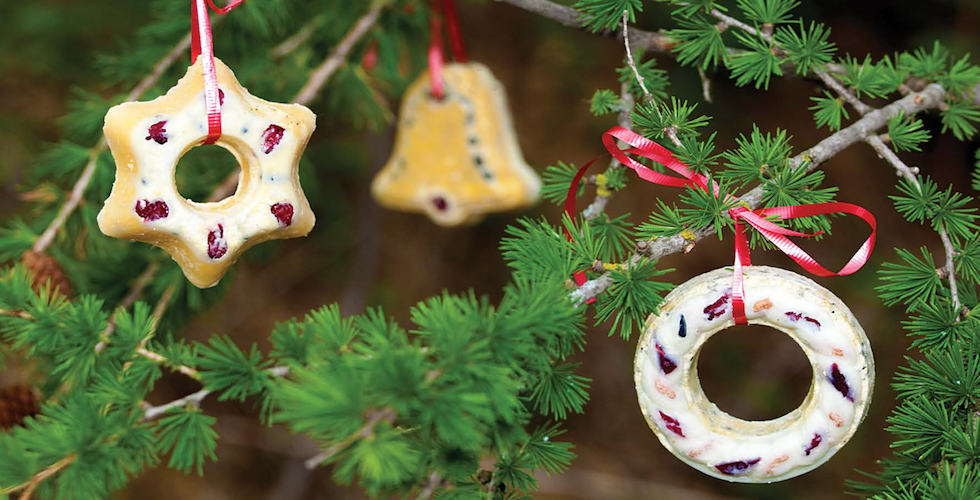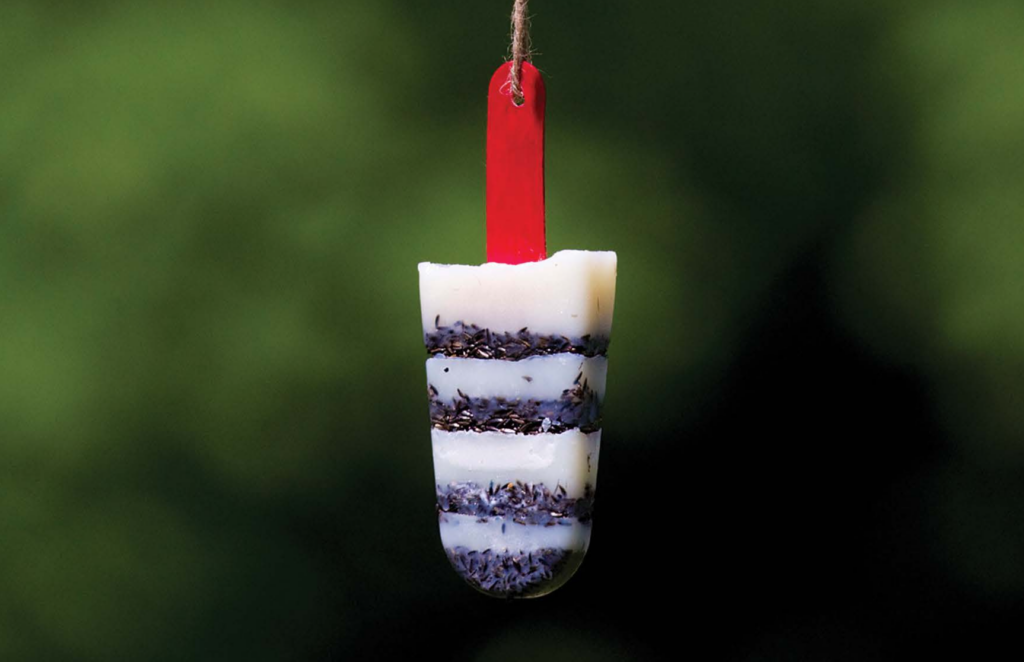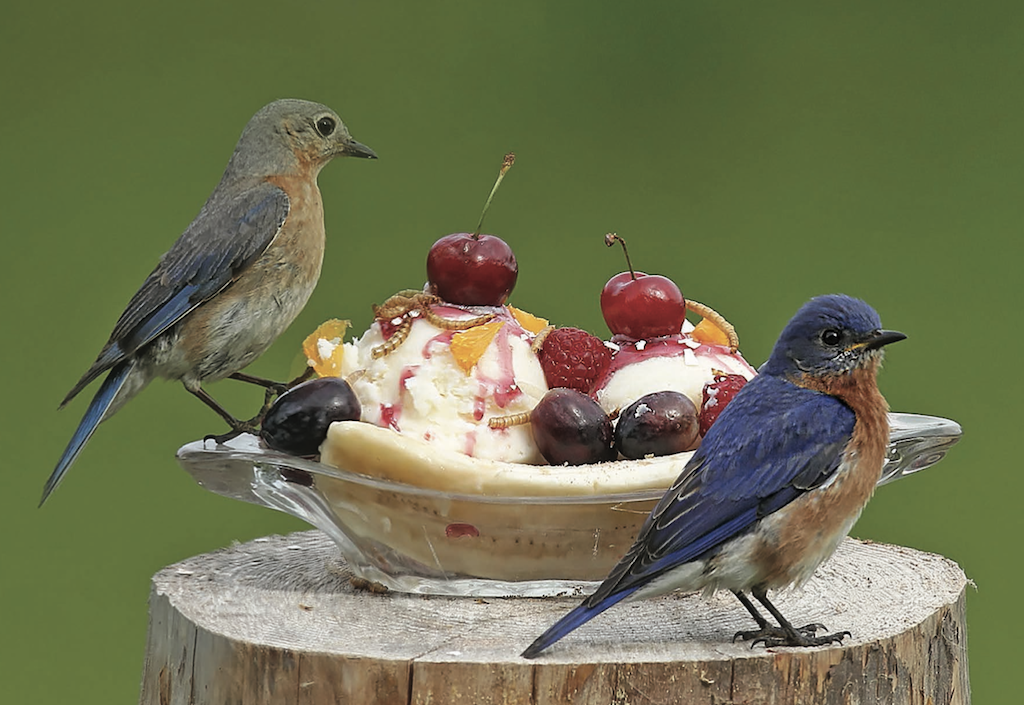
Feed the Birds!
Feed the birds in your backyard with creative recipes from Adele Porter’s book Homemade Bird Food: 26 Fun & Easy Recipes to Feed Backyard Birds. Her 74 recipes are designed to attract up to 74 different bird species, from hummingbirds to orioles and even “hard-to-get” birds in your area. Today, we are sharing two recipes with you.
With winter just around the corner, it is even more important to feed the birds. Just as dessert is only one part of a meal, the food eaten by backyard birds is only a supplement to their full energy requirements. Research indicates that just over 20% of the winter energy needs of chickadees are gained from food sources at bird-feeding stations.
Fill the water glasses (bird baths) all year too. Birds fulfill their water needs from direct sources like puddles and bird feeders, as well as indirect sources such as the moisture content in foods and from respiration. Mourning doves must visit a water source at least once per day. Bring on the feast!
ZEBRA-STRIPED SUET-SICLES
INGREDIENTS
3 cups of suet, melted
1 cup Nyjer seed
TOOLS
Ice-pop mold or small paper cups
Ice-pop sticks or craft sticks
String, yarn, twine, or raffia

HOW TO
Place the ice-pop mold or paper cups on a baking sheet with wax paper underneath. Set out a bowl of Nyjer seeds. Lay out the ice-pop or craft sticks. Drill a hole through each stick near the end. (Hint: Some craft sticks come with holes already made.)
Melt 1 cup of suet in a glass measuring cup in the microwave.
Pour 1 inch of melted suet into each cup or ice-pop mold. Place in the refrigerator for about 10 minutes or until the suet starts to cool. Sprinkle a layer of thistle seeds into the partially cooled suet. Push the sticks into the centers of the suet-sicles, keeping the ends with the holes on top. Place back in the refrigerator to cool for about 10 more minutes. Repeat steps 2 and 3 until the mold is full. Chill until hard. Pop the suet-sicles from the mold. If they don’t release easily, place the mold in warm water for 30 seconds.
Place a 12-inch length of string, yarn, twine, or raffia through the hole in the suet-sicle stick, and tie the two ends together in a slipknot. Hang the Zebra-Striped Suet-sicles from a tree branch, feeder support, or suction-cup window hanger. Watch for woodpeckers, chickadees, and other birds to zip in for a suet-sicle treat.
GOOD TO KNOW: Providing suet, seeds, and nuts to backyard birds during the winter offers the fats and carbohydrates needed to fuel their internal furnaces. The smaller the bird, the greater its surface area-to-volume ratio. This requires proportionally more fuel in the way of food consumption. Blue jays need to eat about 10% of their body weight in food per day, but the much smaller chickadees need to eat about 35% of their body weight in food per day. This treat also attracts white-breasted nuthatches, hairy woodpeckers, and Carolina and mountain chickadees.
BANANA SPLIT
INGREDIENTS
1 peeled banana
Two small scoops of suet base, suet-fruit combo, or nutty suet
1⁄4 cup grape jelly
Half an orange, peeled and cut into pieces
Handful of grapes, halved
2 cherries
Shelled peanuts or other seeds
1 crushed eggshell
Live mealworms (optional—but the warblers and bluebirds would say required!)
TOOLS
Ice-cream scoop
Banana split dish or recycled container

HOW TO
Slice the banana in half lengthwise, and place both halves in a dish that can be kept outside. (Secondhand stores often have banana split dishes for sale, or you can be creative and recycle a leftover container.) Place two scoops of suet base between the banana halves. (Hint: Warm the scoop in hot water to allow it to scoop and release the suet more easily.)
Heat the jelly until it is melted. Drizzle the jelly over the mounds of suet. Next, place the fruit pieces, nuts, and seeds around the suet. During winter in northern regions, substitute peanuts and other nuts and seeds for the fruit. Sprinkle the crushed eggshell and, if desired, squirmy mealworms on top.
GOOD TO KNOW: The black-billed magpie; tufted titmouse; red-breasted nuthatch; eastern towhee; yellow-bellied sapsucker; downy, hairy, red-bellied, and red-headed woodpecker; and mountain chickadee will all love this recipe. Place the Banana Split on a tree stump or another elevated stand near tree branches (but not accessible to roaming cats and squirrels) in the spring and fall when warblers migrate. Eastern bluebirds will eat from this protein-packed meal during the summer nesting season.
If you enjoyed this post, sign up for our newsletter now! #bewellbeoutdoors



Annie Long
These lovely treats make me wish I was a bird! So clever and a creative way to engage with wild creatures. I love this!